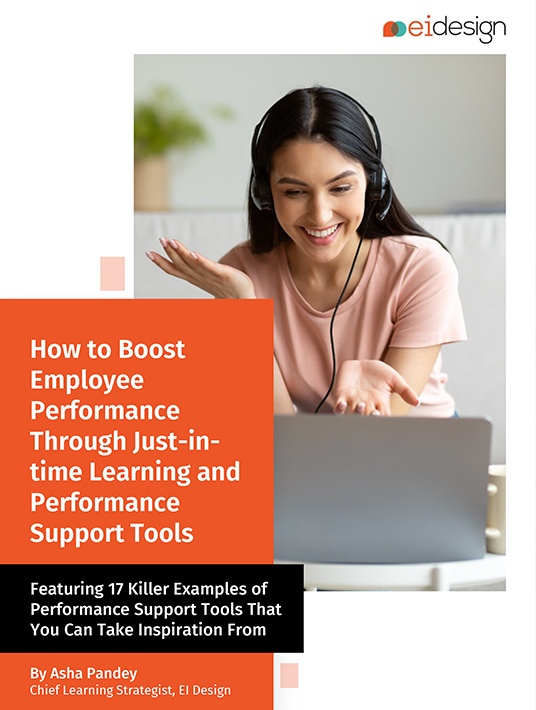Discover 17 Killer Examples Of Performance Support Tools That You Can Take Inspiration From
Performance support tools and Just-In-Time learning are two of the most efficient L&D practices today. Many organizations do not have a structured approach to support training beyond formal or structured training. Performance support tools or PSTs fill this gap perfectly. They can be used to support formal training and drive Just-In-Time learning. This amazing eBook shows you exactly how to integrate them into your learning strategy and see the “performance changing” gains accrue with these “just-in-time” learning aids.

About The eBook How To Boost Employee Performance Through Just-In-Time Learning And Performance Support Tools
This eBook is divided into 3 sections. It starts by introducing the concept of PSTs and Just-In-Time training and then gradually helps you incorporate this material into your organization's daily L&D practices.
1. What Are Performance Support Tools And What Is Their Value Proposition?
The first section of the eBook begins by explaining what performance support tools are and how they are different from training. It showcases the differences between those two approaches and thoroughly explains how PSTs improve the application of learning. I found the examples given really to-the-point. This is an excellent introduction to the eBook. It highlights all the necessary key points to further the discussion in the following chapters. I also really appreciated the inclusion of the famous quote from Gloria Gery:
Performance Support focuses on work itself while training focuses on the learning required to do the work. Integrating resources in the workplace is inevitable, and the need is urgent. Filtering resources so that people get the tools and resources they need while actively working is the goal. Work process and roles are the primary filters. The mechanisms vary [...] but what’s important is that the performer is able to name that tune in one note, to perform in an exemplary fashion. Short, focused, and action oriented, they support formal training and are designed to be available in the learner’s workflow, rather than having to log on to the LMS and secure this specific information.
2. How To Drive Just-In-Time Learning With Performance Support Tools
The next section of the eBook focuses on connecting PSTs with Just-In-Time learning. Following a thorough and well-written explanation of what Just-In-Time learning is, there is a beneficial presentation of how performance support tools help learners improve their performance. This is really important because it helps you translate everything you have learned about PSTs into actionable items that can impact your organization's goals. In the same spirit, the eBook also covers how performance support tools benefit Just-In-Time learning in the workplace. There is also a segment that helps you fit Just-In-Time learning into your organization's overall training strategy.
3. How To Enable Just-In-Time Learning Through Performance Support Tools
The final chapter of this eBook helps you connect all the points you have discovered so far and enable Just-In-Time learning in your workplace. Here you will find many practical examples of things you can use, such as:
- Interactive PDFs
- Short videoclips
- Interactive infographics
- eBooks
- HTML5 flipbooks
- Animated videos
- Whiteboard animations
- Explainer videos
- Expert videos
- Recorded webinars
- Audiobooks and podcasts
- Parallax learning paths
- Mobile apps
- Branching scenarios
- Scrollable single web pages
- Minigames
- Short digital resources
These examples are explained in detail and are sure to make fine additions to your L&D scheme.
In Conclusion
Learning and improvements in performance connect. Training has long been the traditional approach to improve performance. However, formal training is often not enough to ensure that your workers use their acquired learning. This is exactly where PSTs fit in, as Just-In-Time learning aids available to learners within their workflow. EI Design has done, once again, an amazing job in creating an insightful resource for the modern L&D professional. To learn more about performance support tools and Just-In-Time training, download the eBook How To Boost Employee Performance Through Just-In-Time Learning And Performance Support Tools.









